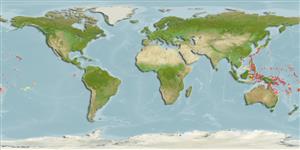Actinopterygii (ray-finned fishes) >
Perciformes (Perch-likes) >
Gobiidae (Gobies) > Gobionellinae
Etymology: Oxyurichthys: Greek, oxys = sharpen + Greek, oura = tail + Greek, ichthys = fish (Ref. 45335).
Environment / Climate / Range
Ecology
Marine; demersal; depth range 1 - 4 m (Ref. 90102). Tropical, preferred ?
Pacific: Hawaii and Indonesia.
Size / Weight / Age
Maturity: Lm ? range ? - ? cm
Max length : 4.7 cm SL male/unsexed; (Ref. 28618)
Dorsal
spines
(total): 6 - 7;
Dorsal
soft rays
(total): 12-13;
Anal
spines: 1;
Anal
soft rays: 12 - 14. Characterized by pale brownish grey body color with three longitudinal rows of dark brown spots on body;, upper row as double spots and middle row as large rectangular blotches; pectoral fin base covered by a large oval blackish spot; irregular dark brown bar below eye; dorsal fins joined basally by membrane; united pelvic fins, well-developed frenum present; long and pointed caudal fin, 2.4-2.7 in SL; longitudinal scale series 100; ctenoid scales posteriorly, becoming cycloid anteriorly; head, nape, prepectoral area and breast without scales; low fleshy crest from above upper end of preopercular margin to origin of first dorsal fin; depth of body 5.3-5.7 in SL (Ref. 90102).
Benthic on mud in shallow brackish waters (Ref. 58302). Also found in sand bottoms in estuaries and stream mouths in 1-4 m (Ref. 90102).
Life cycle and mating behavior
Maturity | Reproduction | Spawning | Eggs | Fecundity | Larvae
Benthic spawner.
Pezold, F., 1998. Three new species of Oxyurichthys (Teleostei: Gobiidae) from the Indian and Pacific oceans. Copeia 1998(3):687-695. (Ref. 28614)
IUCN Red List Status (Ref. 115185)
CITES (Ref. 94142)
Not Evaluated
Threat to humans
Harmless
Human uses
More information
ReferencesAquacultureAquaculture profileStrainsGeneticsAllele frequenciesHeritabilityDiseasesProcessingMass conversion
Tools
Special reports
Download XML
Internet sources
